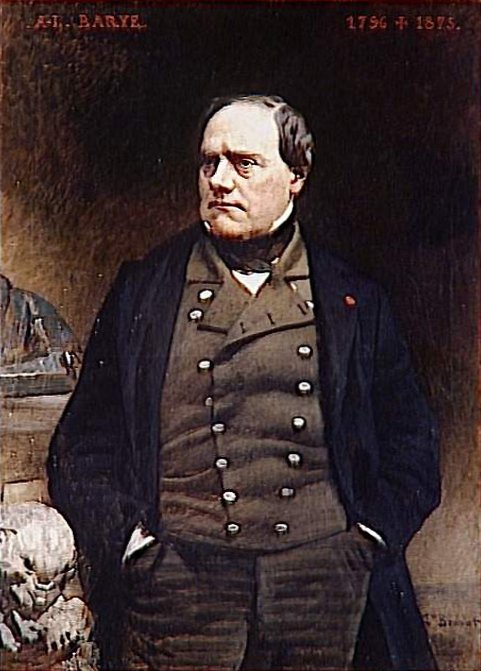- Antoine-Louis Barye
Infobox Person
name = Antoine-Louis Barye

image_size = 250px
caption = Portrait fromLéon Bonnat
birth_date =September 24 ,1796
birth_place =Paris ,France
death_date =June 25 ,1875
death_place =
education =
occupation = Sculptor
spouse =
parents =
children =Antoine-Louis Barye (
September 24 ,1796 -June 25 ,1875 ) was a French sculptor most famous for his work as ananimalier .Born in
Paris , Barye began his career as agoldsmith , like many sculptors of the Romantic Period. After studying under sculptor Francois-Joseph Bosio and painter Baron Antoine-Jean Gros he was in 1818 admitted to theÉcole des Beaux Arts . But it was not until 1823, while working for Fauconnier, the goldsmith, that he discovered his true predilection from watching the wild beasts in theJardin des Plantes , making vigorous studies of them in pencil drawings comparable to those ofDelacroix , then modelling them in sculpture on a large or small scale.In 1831 he exhibited his "Tiger devouring a Crocodile", and in 1832 had mastered a style of his own in the "Lion and Snake." Thenceforward Barye, though engaged in a perpetual struggle with want, exhibited year after year these studies of animals--admirable groups which reveal him as inspired by a spirit of true romance and a feeling for the beauty of the antique, as in "
Theseus and theMinotaur " (1847), "Lapitha andCentaur " (1848), and numerous minor works now very highly valued.Barye was no less successful in
sculpture on a small scale, and excelled in representing animals in their most familiar attitudes. Examples of his larger work include the "Lion of the Column of July," of which the plaster model was cast in 1839, various lions and tigers in the gardens of theTuileries , and the four groups--"War, Peace, Strength, and Order" (1854).In 1852 he cast his bronze "Jaguar devouring a Hare." Fame came late in the sculptor's life. He was made Professor of Drawings at the Museum of Natural History in 1854, and was elected to the Academy of Fine Arts in 1868. No new works were produced by Barye after 1869.
The mass of admirable work left by Barye entitles him to be regarded as one of the great animal life artists of the French school, and the refiner of a class of art which has attracted such men as
Emmanuel Frémiet , Peter, Cain, andGardet .References
*
Emile Lam , "Les Sculpteurs d'animaux: M. Barye" (Paris. 1856)
*Gustave Planche , "M. Barye,Revue des deux mondes " (July 1851)
*Théophile Silvestre , "Histoires des artistes vivants" (Paris, 1856)
*Arsène Alexandre , "A. L. Barye, Les Artistes célébres", ed. E. Muntz (Paris, 1889) (with a bibliog.)
*Charles DeKay , "Life and Works of A. L. Barye" (1889), published by the Barye Monument Assoc. of New York
* Jules Claretie, "Peintres et sculpteurs contemporains" (1882)
*Roger Ballu , "L'œuvre de Barye" (1890)
*Charles Sprague Smith , "Barbizosz Days" (1903)External links
* [http://bronze-gallery.com/special/exhibits.cfm?exhibitID=3 A Gallery Rotation of 50 bronze sculptures by Antone Louis Barye]
* [http://www.hillstead.org/collection/sculpture.html Antoine-Louis Barye at Hill-Stead Museum, Farmington, Connecticut]
* The R.W. Norton Art Gallery: [http://www.rwnaf.org/antoine-louis_barye.html Antoine-Louis Barye's Biography]
Wikimedia Foundation. 2010.
